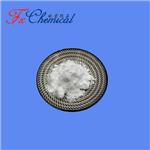The Comprehensive Guide to Rituximab: Mechanisms, Applications, and Care
Apr 12,2024
Introduction
Rituximab, a pioneering chimeric monoclonal antibody, has been a beacon of hope in the realms of oncology and immunology. Designed to target CD20-positive B cells, it offers a novel approach to treating various conditions that were previously challenging to manage. Its introduction into the medical field has not only provided patients with new hope but has also spurred a wave of innovation in therapeutic strategies. This article aims to dissect the multifaceted aspects of Rituximab, exploring its mechanism of action, its diverse applications, the spectrum of side effects, and its storage protocols, all through the lens of a chemical professional[1].

Fig. 1 Characteristics of Rituximab
Mechanism of Action
The mechanism of action of Rituximab is a testament to the elegance of targeted therapy in modern medicine. By zeroing in on the CD20 antigen on B cells, Rituximab initiates a cascade of immunological events leading to the selective depletion of these cells. This process is crucial in diseases where B cells play a pivotal role, whether they are malignantly transformed or pathologically active in autoimmune disorders. The antibody-dependent cellular cytotoxicity (ADCC) mechanism is particularly notable, where Rituximab binds to CD20 and recruits immune effector cells to induce the lysis of the target cell. Additionally, complement-dependent cytotoxicity (CDC) plays a role, where Rituximab activation leads to the complement cascade, culminating in cell destruction. These mechanisms highlight the sophisticated interplay between the therapeutic agent and the immune system, offering a targeted approach to treatment that spares non-target cells, thus reducing collateral damage[2].
Applications
The therapeutic applications of Rituximab are extensive and varied. In oncology, its efficacy in treating B-cell malignancies, such as Non-Hodgkin's Lymphoma (NHL) and Chronic Lymphocytic Leukemia (CLL), has been well-documented. These malignancies, which were once daunting challenges, are now met with a targeted approach that offers improved outcomes and new hope for patients. Beyond oncology, Rituximab has made significant strides in the treatment of autoimmune diseases. In conditions like Rheumatoid Arthritis (RA) and Systemic Lupus Erythematosus (SLE), Rituximab has provided a therapeutic option when traditional treatments have failed, demonstrating its versatility and effectiveness. The expanding applications of Rituximab in medicine are a testament to the ongoing research and clinical trials that continue to uncover its potential in treating a broader spectrum of diseases[3].
Side Effects
While Rituximab is a beacon of therapeutic innovation, its administration is associated with a range of side effects that necessitate vigilant management. The infusion-related reactions, characterized by fever, chills, and body aches, underscore the body's response to the foreign antibody. Furthermore, the increased risk of infections and hematological side effects demands a careful assessment of the patient's condition and proactive management strategies. These side effects, while manageable, underscore the importance of a comprehensive understanding of Rituximab's impact on the body, ensuring that its therapeutic benefits are maximized while minimizing potential risks.
Storage Recommendations
The efficacy and safety of Rituximab hinge on its proper storage. Maintaining the antibody at 2 to 8 degrees Celsius, away from light, and ensuring it is not frozen, are critical to preserving its structural integrity and pharmacological activity. These storage conditions are paramount in ensuring that the therapeutic potential of Rituximab is fully realized when administered to patients, reflecting the broader principles of pharmaceutical care in maintaining the quality and effectiveness of medications.
This in-depth exploration of Rituximab underscores its pivotal role in contemporary medicine, illustrating the complex interplay of chemistry, biology, and medical science in developing and deploying a targeted therapeutic agent. As we continue to unravel the full potential of Rituximab, it remains a symbol of the advances in medical science, offering new avenues of hope for patients across the globe.
References
[1]Onrust S V, Lamb H M, Barman Balfour J A. Rituximab[J]. Drugs, 1999, 58: 79-88.
[2]Weiner G J. Rituximab: mechanism of action[C]//Seminars in hematology. WB Saunders, 2010, 47(2): 115-123.
[3]Johnson P W M, Glennie M J. Rituximab: mechanisms and applications[J]. British journal of cancer, 2001, 85(11): 1619-1623.
- Related articles
- Related Qustion
- Several mechanisms of action of rituximab Apr 10, 2024
Rituximab has become a mainstay in treating a broad variety of B-cell malignancies.
- Rituximab—The World"s First Oncology Monoclonal Antibody Therapy Jan 29, 2023
Rituximab, sold under the brand name Rituxan among others, is a monoclonal antibody medication used to treat certain autoimmune diseases and types of cancer.
2-Methoxy-4-nitroaniline is an important industrial compound used in dye manufacturing and as an intermediate in the synthesis of other compounds.....
Apr 12,2024APIThe discovery of Fullerene C60 has paved new avenues in nanotechnology and provided a fresh perspective on the uncharted territories of carbon-based materials.....
Apr 12,2024APIRituximab
174722-31-7You may like
- Rituximab
-

- $0.00 / 1G
- 2024-10-14
- CAS:174722-31-7
- Min. Order: 1G
- Purity: 98%min
- Supply Ability: 30kg/month
- Rituximab USP/EP/BP
-

- $1.10 / 1g
- 2021-07-02
- CAS:174722-31-7
- Min. Order: 1g
- Purity: 99.9%
- Supply Ability: 100 Tons Min
- Rituximab
-

- $0.00 / 1Kg
- 2020-05-03
- CAS:174722-31-7
- Min. Order: 1KG
- Purity: 99.0%
- Supply Ability: 800 ton






